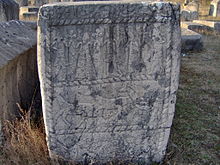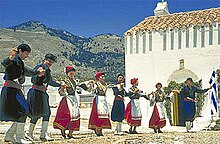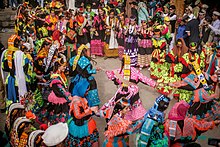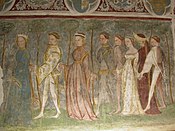Circle dance

Circle dance, or chain dance, is a style of
Being probably the oldest known dance formation, circle dancing is an ancient
Distribution
Modern circle dancing is found in many cultures, including
History
Balkans

Medieval tombstones called
In Macedonia, near the town of Zletovo, the murals on the monastery of Lesnovo (Lesnovo Manastir), which date from the 14th century, show a group of young men linking arms in a round dance.[6] A chronicle from 1344 urges the people of the city of Zadar to sing and dance circle dances for a festival. However, a reference comes from Bulgaria, in a manuscript of a 14th-century sermon, which called chain dances "devilish and damned."[7]
Central Europe
The circle dance of Germany is called "Reigen"; it dates from the 10th century, and may have originated from devotional dances at early
Mediterranean
In the 14th century, Giovanni Boccaccio describes men and women circle dancing to their own singing or accompanied by musicians.[14] One of the frescos in Siena by Ambrogio Lorenzetti painted in 1338–1340 show a group of women doing a "bridge" figure while accompanied by another woman playing the tambourine.[15]
There are accounts of two western European travelers to Constantinople, the capital of the Ottoman Empire. In 1577, Salomon Schweigger describes the events at a Greek wedding:[16]
then they joined arms one upon the other, made a circle, went round the circle, with their feet stepping hard and stamping; one sang first, with the others all following after.[16]
Another traveler, the German pharmacist Reinhold Lubenau, was in Constantinople in November 1588 and reports on a Greek wedding in these terms:[17]
a company of Greeks, often of ten or more persons, stepped forth to the open place, took each other by the hand, made a round circle, and now stepped backward, now forward, sometimes went around, singing in Greek the while, sometimes stamped strongly on the ground with their feet.[17]
-
The Italian circle dance made up of females, which features the "bridge"
-
Medieval circle dancing, South Tyrol, Italy

In Denmark, old ballads mention a closed circle dance which can open into a chain dance. A fresco in Ørslev church in Zealand from about 1400 shows nine people, men and women, dancing in a line. The leader and some others in the chain carry bouquets of flowers. In the case of women's dances, there may have been a man who acted as the leader.[18][19] In Sweden, medieval songs often mentioned dancing. A long chain was formed, with the leader singing the verses and setting the time while the other dancers joined in the chorus.[20]
Modern dances
Eastern Europe
Hora
The Hora dance originates in the Balkans but is also found in other countries (including Romania and Moldova). The dancers hold each other's hands and the circle spins, usually counterclockwise, as each participant follows a sequence of three steps forward and one step back. The Hora is popular during wedding celebrations and festivals, and is an essential part of social entertainment in rural areas. In Bulgaria, it is not necessary to be in a circle; a curving line of people is also acceptable.[21]
Kolo
The
Southern Europe

Kalamatianos
The
4.[24]
Sardana

Sardana is a type of circle dance typical of Catalonia. It would usually have an experienced dancer leading the circle. The dancers hold hands throughout the dance: arms down during the curts and raised to shoulder height during the llargs. The dance was originally from the Empordà region, but started gaining popularity throughout Catalonia during the 20th century. There are two main types, the original Sardana curta (short Sardana) style and the more modern Sardana llarga (long Sardana).[25]
Syrtos
Syrtos and Kalamatianos are Greek dances done with the dancers in a curving line holding hands, facing right. The dancer at the right end of the line is the leader. The leader can also be a solo performer, improvising showy twisting skillful moves as the rest of the line does the basic step. In some parts of Syrtos, pairs of dancers hold a handkerchief from its two sides.[26][27]
Western Europe
An Dro

Faroese chain dance
The
Sacred Circle Dance
The Sacred Circle Dance was brought to the
Middle East
Dabke

Dabke is popular in Lebanon, Syria, Palestine, Israel, Jordan and Turkey. The most famous type of the dance is the Al-Shamaliyya (الشمالية). It consists of a lawweeh (لويح) at the head of a group of men holding hands and formed in a semicircle. The lawweeh is expected to be particularly skilled in accuracy, ability to improvise, and quickness (generally light on his feet). The dancers develop a synchronized movement and step, and when the singers finish their song the lawweeh breaks from the semicircle to dance on their own. The lawweeh is the most popular and familiar form of dabke danced for happy family celebrations.[32]
Govend

Khigga

Kochari
Tamzara
prevalent in south Asia in Himachal Pradesh, Kashmir,
South Asia
India
Circle dance is prevalent in

Pakistan
Folk dance of Kalash people of Chitral District of Pakistan is a circle dance.[49]

Nepal
Dhan Nach of Limbu people, Syabru (dance) of Sherpa and Hyolmo people, Sakela of Rai people, Deuda of Khas people are some of the popular circle dances of Nepal.[50]

See also
References
- ISBN 978-0808707271.
- ^ "We ended with a circle dance." "A short session of circle dance was one of the activities on offer...""Archived copy" (PDF). Archived from the original (PDF) on 14 February 2012. Retrieved 24 February 2013.
{{cite web}}: CS1 maint: archived copy as title (link) - ^ Chivers, C. J. (24 May 2006). "A Whirling Sufi Revival With Unclear Implications". The New York Times. Retrieved 22 April 2020.
Three circles of barefoot men, one ring inside another, sway to the cadence of chant. The men stamp in time as they sway, and grunt from the abdomen and throat, filling the room with a primal sound. One voice rises over the rest, singing variants of the names of God.
- ^ Alojz Benac "Chapter XIII: Medieval Tombstones (Stećci)" in Bihalji-Merin, Otto, ed. (1969). Art Treasures of Yugoslavia. New York: Abrams. pp. 277–296.
- ^ Bihalji-Merin, Otto; Benac, Alojz (1962). The Bogomils. London: Thames.
- ^ "Historical view on the Lesnovo monastery". Ilija Velev (University of Skopje). Archived from the original on 6 July 2011. Retrieved 15 November 2010.
- ^ Katzarova-Kukudova, Raina; Djenev, Kiril (1958). Bulgarian Folk Dances. Cambridge, Massachusetts: Slavica. p. 9.
- ^ Goldschmidt, Aenne (1978). Handbuch des Deutschen Volktanzes. Wilhelmshaven: Heinrichshofen. p. 27.
- ^ Fyfe, Agnes (1951). Dances of Germany. London: Max Parrish. pp. 8–9.
- ^ Martin, György (1974). Hungarian Folk Dances. Budapest: Corvina Press. p. 17.
- ^ "Runkelstein Castle - The illustrated castle A short history". Archived from the original on 6 October 2016. Retrieved 14 November 2010.
- ^ Lubinová, Mila (1949). Dances of Czechoslovakia. New York: Chanticleer Press. p. 8.
- ISBN 0-7818-0420-5.
- .
- ^ Bragaglia, Anto Giulio (1952). Danze popolari italiane [Popular Italian Dances] (in Italian). Roma: Edizioni Enal.
- ^ a b Schweigger, Salomon (1964). Ein newe Reyssbeschreibung auss Teutschland nach Constantinopel und Jerusalem. Graz: Akademische Druck- u. Verlagsanstalt. p. 227.
- ^ a b Lubenau, Reinhold (1915). Sahm, W. (ed.). "Beschreibung der Reisen des Reinhold Lubenau" [Account of the Journes of Reinhold Lubenau]. Mitteilungen aus der Stadtbibliothek zu Koenigsberg i. Pr. (in German). VI: 23.
- ^ Lorenzen, Poul; Jeppesen, Jeppe (1950). Dances of Denmark. New York: Chanticleer Press. pp. 7–10.
- ^ Curt Sachs (1963) World History of the Dance, p.263
- ^ Salvén, Erik (1949). Dances of Sweden. London: Max Parrish. p. 8.
- ^ "'Hora' History". forward.com. 12 December 2007. Retrieved 22 April 2020.
- ^ Costumes. (2009). In ASKA Kolo Ansambl. Retrieved March 26, 2009, from ASKA Kolo Ansambl "ASKA Kolo Ansambl in Sacramento, California - Home". Archived from the original on 22 February 2012. Retrieved 1 July 2014.
- ^ kolo. (2009). In Encyclopædia Britannica. Retrieved 26 March 2009, http://www.britannica.com/EBchecked/topic/321451/kolo
- ^ Lykesas, George H. (1993). Οι Ελληνικοί Χοροί [Greek Dances] (in Greek) (Second ed.). Thessaloniki: University Studio Press.
- ^ "Origin of the Sardana" (in Spanish). Lavanguardia.es. 16 March 2010. Archived from the original on 12 March 2020. Retrieved 27 July 2013.
- ^ σύρω, Henry George Liddell, Robert Scott, A Greek-English Lexicon, on Perseus
- ^ συρτός Henry George Liddell, Robert Scott, A Greek-English Lexicon, on Perseus
- ^ Bacher, Elsa; Ruling, Ruth (March 1998). "An Dro Retourne" (PDF). Folk Dance Federation of California. Retrieved 4 April 2020.
- ^ "Faroese Chain Dance". Faroe Islands.fo. Archived from the original on 4 July 2022. Retrieved 4 April 2020.
- ISBN 0-9547230-8-2.
- ^ See many issues of Grapevine over its 25 years history, available via www.circledancenetwork.org.uk
- ^ "Dabke: The Dance of the Lebanese Village". Sourat. Archived from the original on 18 September 2012. Retrieved 31 October 2010.
- ^ "Kurdish Dance". The Kurdish Project. Retrieved 9 September 2021.
- Smithsonian Magazine. Retrieved 9 September 2021.
- ^ BetBasoo, Peter Pnuel (30 April 2003). "Thirty Assyrian Folk Dances" (PDF).
- doi:10.7916/D8S75QNP. Retrieved 6 November 2013.)
{{cite journal}}: Cite journal requires|journal=(help - ^ Vvedensky, Boris, ed. (1953). Great Soviet Encyclopedia (in Russian). Vol. 23 (Second ed.). Moscow: Soviet Encyclopedia. p. 170.
КОЧАРИ — армянский народный мужской танец.
- ISBN 978-0823686582.
..and in the sixth scene one of the dances of the gladiators is very reminiscent of Kochari, the Armenian folk dance.
- ^ BetBasoo, Peter Pnuel (30 April 2003). "Thirty Assyrian Folk Dances" (PDF). Assyrian International News Agency. Retrieved 6 November 2013.
- ^ "Kotsari". Pontian.info. Archived from the original on 16 October 2012. Retrieved 6 November 2013.
- ^ Ю.В. Келдыш, М.Г. Арановский, Л.З.Корабельникова (1990). Kochari - Musical Encyclopedic Dictionary (in Russian). Soviet Encyclopedia. p. 275.
{{cite book}}: CS1 maint: multiple names: authors list (link) - ^ "The National Dancings". Nakhchivan Autonomous Republic. Retrieved 6 November 2013.
- ISBN 978-1741046564.
- ^ "PontosWorld". pontosworld.com. Retrieved 22 April 2020.
- ^ "Himachal Pradesh Dances - Folk Dances of Himachal Pradesh, Traditional Dance Himachal Pradesh India". Bharatonline. Retrieved 5 November 2022.
- ISSN 2454-2423.
- ^ "Out of the Dark". democratic world.
- ^ "Goan Folk Arts". Goajourney. Retrieved 5 November 2022.
- ^ "Kalash Valley: Life revolves around festivals". gulfnews. 6 July 2010. Retrieved 8 May 2023.
- ^ "'गीत गाउन... अनुरोध गरेँ है !'". GorakhaPatra. Archived from the original on 23 February 2022. Retrieved 3 May 2023.
Journals
- Drumbeat, the South African circle dancing journal.
- Grapevine, the quarterly journal of Circle Dance Friends. ISSN 1752-4660
Further reading
- Laura Hellsten, Laura (2021) Through the Bone and Marrow - Re-examining Theological Encounters with Dance in Medieval Europe. Brepols.
- Kathryn Dickason (2020) Ringleaders of Redemption - How Medieval Dance Became Sacred. Oxford University Press.
- Lynn Frances and Richard Bryant-Jefferies (1998) The Sevenfold Circle: self awareness in dance, Findhorn Press. ISBN 1-899171-37-1
- Marion Violets Gibson (2006) Dancing on Water, printed in Wales. ISBN 0-905285-79-4
- Matti Goldschmidt, The Bible in Israeli Folk Dances, Ed. Choros
- Judy King, The Dancing Circle, volumes 1–4, Sarsen Press, Winchester, England
- Iris J Stewart (2000) Sacred Woman Sacred Dance: Awakening spirituality through movement and ritual, Inner Traditions, USA ISBN 978-1-62055-054-0
- Bernhard Wosien, Journey of a Dancer (2016) Sarsen Press, Winchester, England.
- ISBN 0-500-81006-0



